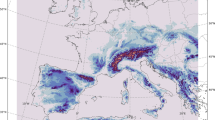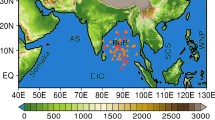Abstract
Diurnal variations of two mountain-plain solenoid (MPS) circulations associated with “first-step” terrain [Tibetan Plateau (TP)] and “second-step” terrain (high mountains between the TP and “east plains”) in China and their influence on the southwest vortex (SWV) and the mei-yu front vortex (MYFV) were investigated via a semi-idealized mesoscale numerical model [Weather Research and Forecasting (WRF)] simulation integrated with ten-day average fields (mei-yu period of 1–10 July 2007). The simulations successfully reproduced two MPS circulations related to first- and second-step terrain, diurnal variations from the eastern edge of the TP to the Yangtze River-Huaihe River valleys (YHRV), and two precipitation maximum centers related to the SWV, MYFV. Analyses of the averaged final seven-day simulation showed the different diurnal peaks of precipitation at different regions: from the afternoon to early evening at the eastern edge of the TP; in the early evening to the next early morning in the Sichuan Basin (SCB); and in the late evening to the next early morning over the mei-yu front (MYF). Analyses of individual two-day cases confirmed that the upward branches of the nighttime MPS circulations enhanced the precipitation over the SWV and the MYFV and revealed that the eastward extension of the SWV and its convection were conducive to triggering the MYFVs. The eastward propagation of a rainfall streak from the eastern edge of the TP to the eastern coastal region was primarily due to a series of convective activities of several systems from west to east, including the MPS between the TP and SCB, the SWV, the MPS between second-step terrain and the east plains, and the MYFV.
Similar content being viewed by others
References
Akiyama, T., 1990: Large, synoptic and meso scale variations of Baiu front, during July 1982, Part II: Front structure and disturbances. J. Meteor. Soc. Japan, 68(5), 557–574.
Bao, X., F. Zhang, and J. Sun, 2011: Diurnal variations of warmseason precipitation east of the Tibetan Plateau over China. Mon. Wea. Rev., 139(9), 2790–2810.
Barnes, S. L., 1973: Mesoscale objective analysis using weighted time-series observations. NOAA Technical Memorandum, ERL, NSSL-62, National Severe Storms Laboratory, Norman, OK 73069, 60 pp. [NTIS-COM-73-10781].
Bei, N., and F. Zhang, 2007: Impacts of initial condition errors on mesoscale predictability of heavy precipitation along the meiyu front of China. Quart. J. Roy. Meteor. Soc., 133, 83–99.
Carbone, R. E., and J. D. Tuttle, 2008: Rainfall occurrence in the United States warm season: The diurnal cycle. J. Climate, 21, 4132–4136.
Carbone, R. E., J. D. Tuttle, and D. Ahijevych, 2002: Inferences of predictability associated with warm season precipitation episodes. J. Atmos. Sci., 59, 2033–2056.
Chen, F., and J. Dudhia, 2001: Coupling an advanced land surface-hydrology model with the Penn State-NCAR MM5 modeling system. Part I: Model implementation and sensitivity. Mon. Wea. Rev., 129, 569–585.
Ding, Y. H., 1993: Study on the Lasting Heavy Rainfalls over the Yangtze-Huaihe River Basin in 1991. China Meteorological Press, Beijing, 255 pp. (in Chinese)
Dudhia, J., 1989: Numerical study of convection observed during the winter monsoon experiment using a mesoscale two dimensional model. J. Atmos. Sci., 46, 3077–3107.
Fu, S. M., J. H. Sun, and S. X. Zhao, 2011: A study of the impacts of the eastward propagation of convective cloud systems over the Tibetan Plateau on the rainfall of Yangtze-Huaihe River basin. Acta Meteorologica Sinica, 69(4), 581–600. (in Chinese)
Geng, B., and H. Yamada, 2007: Diurnal variations of the meiyu/baiu rain belt. SOLA, 3, 61–64.
He, H., and F. Zhang, 2010: Diurnal variations of warm-season precipitation over North China. Mon. Wea. Rev., 138, 1017–1025.
Hong, S.-Y., and J.-O. J. Lim, 2006: The WRF Single-Moment 6-Class Microphysics Scheme (WSM6). J. Korean Meteor. Soc., 42, 129–151.
Hong, S.-Y., J. Dudhia, and S.-H. Chen, 2004: A revised approach to ice microphysical processes for the bulk parameterization of clouds and precipitation. Mon. Wea. Rev., 132, 103–120.
Huang, H. L., C. C. Wang, and G. T. J. Chen, 2010: The role of diurnal solenoidal circulation on propagating rainfall episodes near the eastern Tibetan Plateau. Mon. Wea. Rev., 138, 2975–2989
Joyce, R. J., J. E. Janowiak, and P. A. Arkin, 2004: CMORPH: A method that produces global precipitation estimates from passive microwave and infrared data at high spatial and temporal resolution. J. Hydrometeorology, 5, 487–503.
Kurosaki, Y., and F. Kimura, 2002: Relationship between topography and daytime cloud activity around Tibetan Plateau. J. Meteor. Soc. Japan, 80, 1339–1355.
Maddox, R. A., 1980: Objective technique for separating macroscale and mesoscale features in meteorological data. Mon. Wea. Rev., 108, 1108–1121.
Ninomiya, K., 2000: Large- and meso-a-scale characteristics of Meiyu-Baiu front associated with intense rainfalls in 1–10 July 1991. J. Meteor. Soc. Japan, 78, 141–157.
Noh, Y., W. G. Cheon, and S. Raasch, 2001: The improvement of the K-profile model for the PBL using LES. Preprints, Presentation at Int. Workshop of Next Generation NWP Models, Seoul, South Korea, Laboratory for Atmospheric Modeling Research, 65–66.
Skamarock, W. C., J. B. Klemp, and J. Dudhia, 2005: A description of the advanced research WRF version 2. NCAR Tech. Note TN-468+STR, 88 pp.
Sun, J., and F. Zhang, 2012: Impacts of mountain-plains solenoid on diurnal variations of rainfalls along the mei-yu front over the East China plains. Mon. Wea. Rev., 140, 379–397.
Sun, J. H., S. X. Zhao, G. K. Xu, and Q. T. Meng, 2010: Study on a mesoscale convective vortex causing heavy rainfall during the Meiyu season in 2003. Adv. Atmos. Sci., 27(5), 1193–1209, doi: 10.1007/s00376-009-9156-6.
Tan, Z., F. Zhang, R. Rotunno, and C. Snyder, 2004: Mesoscale predictability of moist baroclinic waves: experiments with parameterized convection. J. Atmos. Sci., 61, 1794–1804.
Tao, S. Y., 1980: Rainstorm in China. Science Press, Beijing, 225 pp. (in Chinese)
Trier, S. B., C. A. Davis, and D. A. Ahijevych, 2006: Mechanisms supporting long-lived episodes of propagating nocturnal convection within a 7-day WRF model simulation. J. Atmos. Sci., 63, 2437–2461.
Trier, S. B., C. A. Davis, and D. A. Ahijevych, 2010: Environmental controls on the simulated diurnal cycle of warm-season precipitation in the continental United States. J. Atmos. Sci., 67, 1066–1090.
Wang, C. C., G. T. J. Chen, and R. E. Carbone, 2004: A climatology of warm-season cloud patterns over east Asia based on GMS infrared brightness temperature observations. Mon. Wea. Rev., 132, 1606–1629.
Wang, C. C., G. T. J. Chen, and R. E. Carbone, 2005: Variability of warm-season cloud episodes over East Asia based on GMS infrared brightness temperature observations. Mon.Wea. Rev., 133, 1478–1500.
Yang, W., and D. Yang, 1987: Numerical experiment of the topographic influence of Qinghai-Xizang Plateau in the barotropic atmosphere. Plateau Meteorology, 6(2), 117–128. (in Chinese)
Yasunari, T., and T. Miwa, 2006: Convective cloud systems over the Tibetan Plateau and their impact on meso-scale disturbance in the meiyu/baiu frontal zone. J. Meteor. Soc. Japan, 84(4), 783–803.
Ye, D.-Z., and Y.-X. Gao, 1979: Meteorology of the Tibetan Plateau, Science Press, Beijing, 122–126. (in Chinese)
Yu, R. C., T. J. Zhou, and A. Y. Xiong, 2007: Diurnal variations of summer precipitation over contiguous China. Geophys. Res. Lett., 34, L01704, doi: 10.1029/2006GL028129.
Zhang, J.-J. and B. Z. Zhu, F. K. Zhu, D. M. Weng, G. W. Sun, J. N. Lu, Y. Q. Peng, and Y. Z. Wang, 1988: The Advancements of Tibetan Plateau Meteorology. Science Press, Beijing, 181–183.
Zhang, S. L., S. Y. Tao, and Q. Y. Zhang, 2002: Large and mesoscale characteristics of intense rainfall in the mid and lower reaches of the Yangtze River. Chinese Science Bulletin, 47(9), 779–786.
Zhang, X. L., S. Y. Tao, and S. L. Zhang, 2004: Three types of heavy rainstorms associated with mei-yu front. Chinese J. Atmos. Sci., 28(2), 187–205. (in Chinese)
Zhao, S. X., S. Y. Tao, and J. H. Sun, 2004: Study on Mechanism of Formation and Development of Heavy Rainfalls on Mei-yu Front in Yangtze River. China Meteorological Press, Beijing, 282 pp. (in Chinese)
Zhao, S. X., L. S. Zhang, and J. H. Sun, 2007: Study of heavy rainfall and related mesoscale systems causing severe flood in Huaihe river basin during the summer of 2007. Climatic and Environmental Research, 12, 713–727. (in Chinese)
Zhuo, G., X. D. Xu, and L. S. Chen, 2002: Instability of eastward movement and development of convective cloud clusters over Tibetan Plateau. Journal of Applied Meteorological Science, 13(4), 448–456. (in Chinese)
Author information
Authors and Affiliations
Corresponding author
Rights and permissions
About this article
Cite this article
Zhang, Y., Sun, J. & Fu, S. Impacts of diurnal variation of mountain-plain solenoid circulations on precipitation and vortices east of the Tibetan Plateau during the mei-yu season. Adv. Atmos. Sci. 31, 139–153 (2014). https://doi.org/10.1007/s00376-013-2052-0
Received:
Revised:
Accepted:
Published:
Issue Date:
DOI: https://doi.org/10.1007/s00376-013-2052-0




